West Suffolk
Explore hidden histories, historic photos, and things you never knew about West Suffolk from the collections and archives of Historic England.
Discover your local listed buildings and places
Introducing some of West Suffolk's most historic sites, included in the National Heritage List for England. Some of these captions have been summarised by AI. Click through for the official List entry. Skip this section and go to place by numbers
Elveden War Memorial
Elveden
Dedicated to those, from three local parishes, who died during the First World War, Elveden War Memorial was unveiled on 21 November 1921.
Denston Hall
Denston
Denston Hall, a Grade II* listed building, features an early 18th-century red brick front and a 16th-century range, combining historical architecture and family lineage intricacies.
Suffolk Record Office, including entrance platform and steps
Bury St. Edmunds
Public library, built 1963-5, designed by Donald McMorran of McMorran and Whitby. Read the official list entry to find out more.
The Dome Sports Centre
Mildenhall
A concrete dome built on 29 April 1977 using the Bini construction system. Read the official list entry to find out more.
Ickworth House
Chevington
Ickworth House, a late 18th-century mansion, is renowned for its impressive architecture and surrounding landscape designed by notable figures, including Lancelot Brown, highlighting...
Euston Park
Euston
Euston Park, designed by Lord Arlington with input from John Evelyn, features a 17th-century pleasure ground and an 18th-century walled garden in a historically significant landscape...
Abbey Gardens and Precincts
Bury St. Edmunds
Abbey Gardens, Bury St Edmunds, holds significant ruins of a medieval abbey, later transformed into public parklands with botanical displays and historical landmarks from the 14th century.
Old Shire Hall and Magistrates Court
Bury St. Edmunds
Former Shire Hall, rebuilt around 1750 and remodelled in the early and mid-C19, now Magistrates and Crown Courts; and Shire Hall, built 1906-7 to the designs of A A Hunt, now Old Shire Hall.
Soham House
Newmarket
Tudor/ Jacobean Revival house built in 1892 to the designs of C J Harold Cooper. Read the official list entry to find out more.
Culford Park
Culford
Culford Park features 19th-century gardens and pleasure grounds, designed by notable figures like Thomas Wright and Humphry Repton, and the site houses Culford School today.
Cathedral Church of St James
Bury St. Edmunds
The Cathedral Church of St James became the Cathedral church of St Edmundsbury and Ipswich in 1914, showcasing intricate architecture with extensions and renovations over centuries.
Bury St Edmunds Yard Signal Box
Bury St. Edmunds
Signal box built in 1888 for the Great Eastern Railway. Read the official list entry to find out more.
Elveden Hall
Elveden
Elveden Hall, a large country mansion, features Classical architecture with Indian and Moorish influences. It was expanded in the late 19th and early 20th centuries.
Lidgate Castle and C16 Fortified Manorial Complex
Lidgate
Lidgate Castle, a C12 variant of a motte and bailey castle remodelled, probably in C16, as a fortified manorial complex. Read the official list entry to find out more.
Nethergate Hotel
Clare
The Nethergate Hotel, a 16th-century timber-framed house, was extensively altered in 1644 by Francis Crosse.
Brandon Railway Station
Weeting-with-Broomhill
Railway station, built between 1844 and 1845 to designs attributed to John Thomas; extended in the 1870s and 1880s. Read the official list entry to find out more.
Harraton Court Stables and attached Trainer's House
Exning
Harraton Court Stables with attached trainer's house, built 1883 for 3rd Earl of Durham (George Lambton) as a training and stud establishment. Read the official list entry to find out more.
Hopton Church of England Voluntary Controlled Primary School
Hopton
A post-war village primary school, designed and built by West Suffolk County Council, and opened in 1973. Read the official list entry to find out more.
Building 58, former RAF Barnham atomic bomb store
Barnham
Maintenance Building 58 was one of two buildings on the site (the other being the much altered Building 62) used for the inspection of bombs brought from the airfields.
Market Cross
Bury St. Edmunds
Market Cross, designed by Robert Adam and built between 1774-1780, is a former playhouse and town hall, now an art gallery with offices.
Church of St Peter and St Paul
Kedington
The Church of St Peter and St Paul in Kedington, mostly from the 15th century, features historical ties to the Barnardiston family and retains original woodwork and monuments.
Ketton House
Kedington
Ketton House is an early 18th-century red brick house with a Rococo staircase hall and original sash windows, located in Kedington.
Church of All Saints
Barrow
The Church of All Saints is a medieval church featuring Norman walling, a 13th-century chancel, and a large early 13th-century tower with historical significance from various centuries.
West Stow Hall
West Stow
West Stow Hall, built by Sir John Crofts in the early 16th century, features a distinctive gatehouse with historical ties to Mary Tudor and Charles Brandon.
Mildenhall Warren Lodge also known as the Old Keeper's Lodge
Mildenhall
The upstanding, earthwork, and buried remains of Mildenhall Warren Lodge. The structure dates to the late C15 or C16 and was ruined in the C20. Read the official list entry to find out more.
Church of St Mary
Depden
The Church of St Mary in Depden, Suffolk, features exceptional medieval fabric from the 12th to 15th centuries, preserved furnishings, and a fine brass memorial to Lady Jermyn from 1572.
Cupola House
Bury St. Edmunds
Town house built in the C17, altered around the 1680s, and extensively rebuilt and restored after a fire 2012-2017. Read the official list entry to find out more.
The Swan Inn
Clare
The Swan Inn is a 17th-century timber-framed building in Clare, featuring historical heraldic carvings linked to the Duchess of York.
Nowton Hall
Nowton
Nowton Hall, dated 1595, was a former farmhouse with historical ties to the Benedictine Abbey of St. Edmundsbury.
Moyses Hall
Bury St. Edmunds
Moyses Hall, a late 12th-century merchant house in Bury St Edmunds, has served as an inn, prison, and police station. It is now a museum, featuring Norman and Gothic windows.
Church of St Nicholas
Denston
The Church of St Nicholas features late 14th and 15th-century architecture, notable for its medieval interior, 15th-century font, and significant brasses including Henry and Margaret Everard...
Church of St Mary
Troston
The Church of St. Mary features 13th-century architecture with significant medieval elements, including a Jacobean Gothic interior and medieval paintings.
Barrow War Memorial
Barrow
First World War memorial obelisk, unveiled 1920, with later additions for the Second World War. Read the official list entry to find out more.
Church of St Peter
Brandon
The Church of St. Peter in Brandon, a Grade I listed building, features medieval origins with significant 19th-century restorations.
Church of St Mary
Newmarket
St. Mary's Church in Newmarket features a medieval design with major 19th-century alterations, including a remodelled chancel and an oak-framed spire on the 15th-century tower.
11, Abbeygate Street
Bury St. Edmunds
11, Abbeygate Street is a historical building featuring 17th to 19th-century architecture with timber framing and an early 19th-century Gothick-style shopfront.
Church of St Mary
Coney Weston
The Church of St Mary, primarily 14th-century, features intricate tracery, a Decorated font, medieval tiles, and underwent significant restoration in 1869.
Church of All Saints
Great Thurlow
The Church of All Saints in Great Thurlow is a Grade II* listed building notable for its medieval C15 fabric, unextended Norman chancel, C12 font, and significant C15-C20 monuments.
Explore more
Search for more listed placesWest Suffolk through time
This timeline shows the first period of use for buildings and places on the National Heritage List for England, just one of the details recorded for every list entry. Click around to see how West Suffolk changes over time. Skip this section and go to aerial photos
Prehistoric Before AD 43
Prehistory covers a million years of human occupation before the Roman invasion and the introduction of writing. Primarily hunter-gatherers of several human species including Neanderthals, the peoples moved across Europe, hunting animals, exchanging ideas and developing complex culture and belief systems including burial rites and astronomical understanding, as at Stonehenge for example.
Roman AD 43 to AD 410
Britain was invaded by four legions of the Roman army in AD 43, who relatively rapidly conquered England from landing points in Kent. Parts of Wales and Scotland soon followed.
Roman culture brought urbanism, monumental buildings, wide-ranging religious beliefs, writing, and strong social hierarchy. The Roman administrative system was withdrawn in AD 410.
Early medieval AD 410 to AD 1066
This period, often associated in England with Anglo-Saxons and Vikings, saw a reduction in urban living from the Roman period and increased migration from northern Europe.
Traces of this period can be found in cemeteries, particularly in artefacts and in some of the very early churches, as this period also saw the growth of Christianity in Britain.
Medieval AD 1066 to AD 1540
This period, sometimes known as the Middle Ages, began with the Norman invasion in AD 1066. It saw a significant rise in military and defensive buildings such as castles and earthworks, as well as religious houses dominating a largely agricultural landscape.
The monarchy and Church dominated the period, which also saw the break with the Roman Catholic Church and the English reformation.
Post medieval AD 1540 to AD 1901
The Post-Medieval period brought seismic changes to life in England, with religious reformation leading to the democratization of worship and the destruction of hundreds of religious houses.
In parallel, there was a huge expansion of scientific study and enlightenment that permanently altered the nation's social structure and landscape. Industrialization and mass production lead to wider global trade, emigration, and immigration.
20th century AD 1901 to AD 2000
The 20th century saw an incredible expansion of England's transport networks, with suburban growth shadowing rapid infrastructural expansion. The establishment of state schools, hospitals, and modern technical colleges, with new architectural styles, radically changed the appearance of towns and cities.
Two catastrophic world wars and the 1918 pandemic also brought unprecedented change, altering England's built environment and social structures forever.
Prehistoric Before AD 43
Prehistory covers a million years of human occupation before the Roman invasion and the introduction of writing. Primarily hunter-gatherers of several human species including Neanderthals, the peoples moved across Europe, hunting animals, exchanging ideas and developing complex culture and belief systems including burial rites and astronomical understanding, as at Stonehenge for example.
Roman AD 43 to AD 410
Britain was invaded by four legions of the Roman army in AD 43, who relatively rapidly conquered England from landing points in Kent. Parts of Wales and Scotland soon followed.
Roman culture brought urbanism, monumental buildings, wide-ranging religious beliefs, writing, and strong social hierarchy. The Roman administrative system was withdrawn in AD 410.
Early medieval AD 410 to AD 1066
This period, often associated in England with Anglo-Saxons and Vikings, saw a reduction in urban living from the Roman period and increased migration from northern Europe.
Traces of this period can be found in cemeteries, particularly in artefacts and in some of the very early churches, as this period also saw the growth of Christianity in Britain.
Medieval AD 1066 to AD 1540
This period, sometimes known as the Middle Ages, began with the Norman invasion in AD 1066. It saw a significant rise in military and defensive buildings such as castles and earthworks, as well as religious houses dominating a largely agricultural landscape.
The monarchy and Church dominated the period, which also saw the break with the Roman Catholic Church and the English reformation.
Post medieval AD 1540 to AD 1901
The Post-Medieval period brought seismic changes to life in England, with religious reformation leading to the democratization of worship and the destruction of hundreds of religious houses.
In parallel, there was a huge expansion of scientific study and enlightenment that permanently altered the nation's social structure and landscape. Industrialization and mass production lead to wider global trade, emigration, and immigration.
20th century AD 1901 to AD 2000
The 20th century saw an incredible expansion of England's transport networks, with suburban growth shadowing rapid infrastructural expansion. The establishment of state schools, hospitals, and modern technical colleges, with new architectural styles, radically changed the appearance of towns and cities.
Two catastrophic world wars and the 1918 pandemic also brought unprecedented change, altering England's built environment and social structures forever.
Aerial photos of West Suffolk
Aerial photography helps reveal secrets of England's changing landscapes that are impossible to see from the ground. Skip this section and go to archive images
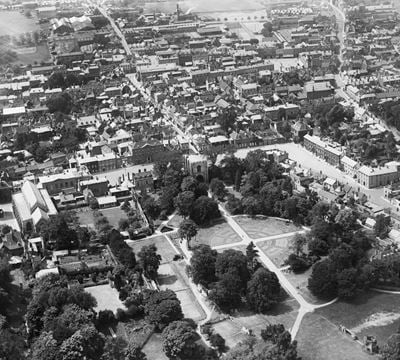
Bury St. Edmunds
St James's Cathedral and Abbey Gardens, Bury St. Edmunds, 1920
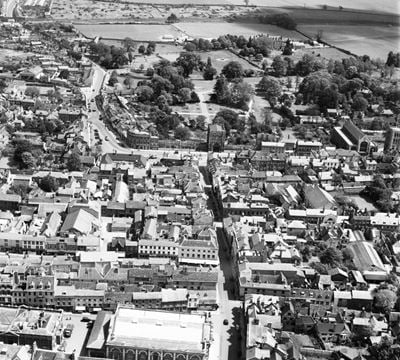
Bury St Edmunds
Abbeygate Street and the abbey, Bury St Edmunds, 1950

Bury St Edmunds
The Chas R. Watson and Co Timber Yard off Southgate Street, Bury St Edmunds, 1953

Bury St Edmunds
The Chas R. Watson and Co Timber Yard off Southgate Street, Bury St Edmunds, 1953

Haverhill
Chauntry Clothing Mills and the town, Haverhill, 1929
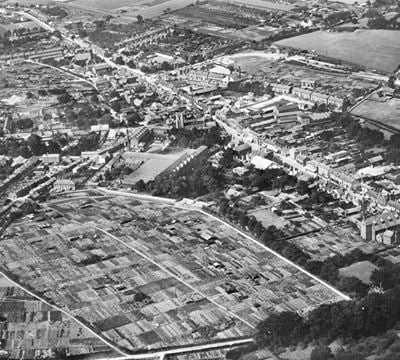
Haverhill
Helion's Wood Allotment Gardens and the town centre, Haverhill, 1929
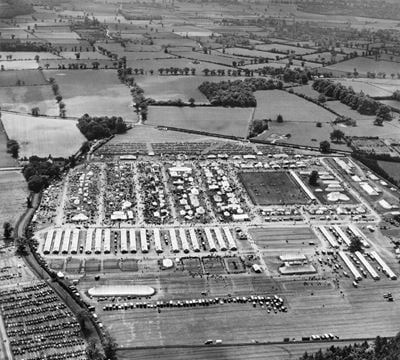
Rougham
Rougham, the Suffolk County Show, 1951
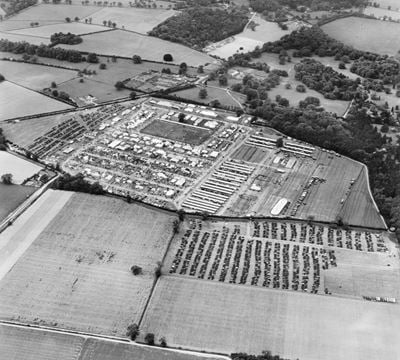
Rougham
Rougham, the Suffolk County Show, 1951
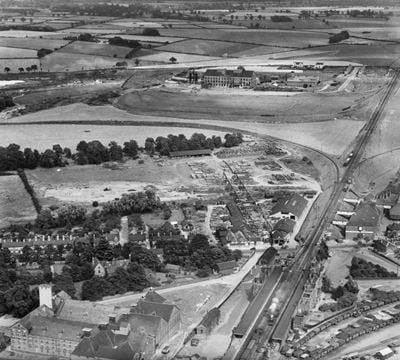
Bury St Edmunds
William Mallinson and Sons Timber Yard, Bury St Edmunds, 1933
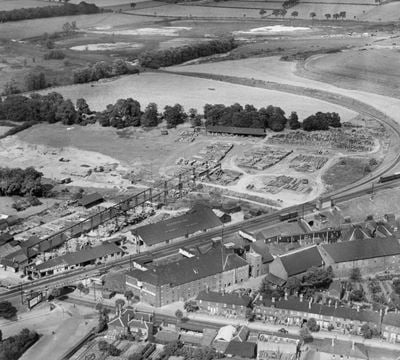
Bury St Edmunds
William Mallinson and Sons Timber Yard and the Northgate Maltings, Bury St Edmunds, 1933
West Suffolk in the Historic England Archive
The Historic England Archive cares for over 15 million images, dating from the 1850s to the present day. Discover stunning images of West Suffolk's past. Skip this section and go to stories about heritage
Charles George Harper Collection
Bradfield Combust, St. Edmundsbury, Suffolk
Date created: 1892 - 1933
Looking north along Sudbury Road towards the Manger public house, with All Saints' Church to the left
Eric de Mare
West Suffolk, Suffolk
Date created: 1945 - 1980
View of an architectural model of Ickworth House made by the architect's brother, the Reverend Joseph Sandys, to a scale of 1 inch to 12 feet.
John Gay Collection: Counties
Denston, St. Edmundsbury, Suffolk
Date created: 1950s
A man driving a tractor on Chantry Farm, Denston, with the Perpendicular style Church of St Nicholas in the background
John Laing Collection
Bury St Edmunds, St. Edmundsbury, Suffolk
Date created: 10 May 1973
Two silos during construction at Bury St Edmunds Sugar Beet Factory, with a man beside the concrete batching plant in the foreground
London, Midland and Scottish Railway Company
Bury St Edmunds, St. Edmundsbury, Suffolk
Date created: 1893
An interior view looking east across the nave of St Mary's Church
Nigel Temple Collection of Postcards of Parks and Gardens
Hardwick, St. Edmundsbury, Suffolk
Date created: 1905 - 1910
VIEW IN THE GARDENS LOOKING TOWARDS THE FOUNTAIN
Eric de Mare
West Suffolk, Suffolk
Date created: 1945 - 1980
View of an architectural model of Ickworth House made by the architect's borther, Reverend Joseph Sandys, to a scale of 1 inch to 12 feet.
John Gay Collection: Counties
Denston, St. Edmundsbury, Suffolk
Date created: 1950s
Interior view of the Church of St Nicholas in Denston, Suffolk, showing a 15th century font amidst pews and piers, and looking towards the alter, with...
John Laing Collection
Bury St Edmunds, St. Edmundsbury, Suffolk
Date created: 26 Nov 1973
Four sugar silos at Bury St Edmunds Sugar Beet Factory, showing the partially constructed conveyor bridge above, with railway tracks in the foreground
London, Midland and Scottish Railway Company
Bury St Edmunds, St. Edmundsbury, Suffolk
Date created: 1893
The octagonal Victorian font in the nave of St Mary's Church
Nigel Temple Collection of Postcards of Parks and Gardens
Bury St Edmunds, St. Edmundsbury, Suffolk
Date created: 1900 - 1905
GENERAL VIEW LOOKING TOWARDS GATEHOUSE
John Gay Collection: Counties
Denston, St. Edmundsbury, Suffolk
Date created: 1950s
Interior view of the Church of St Nicholas in Denston, Suffolk, showing a 15th century font amidst pews and piers, and looking towards the alter, with...
Stories about heritage in your local area
Historic England publishes news, blogs, research, videos, and podcasts celebrating England's rich heritage. Discover the stories we have about West Suffolk. Skip this section and go to education
10 Spectacular Sites to Visit in Suffolk
Mentions Palace House and entrance steps
Home to the most easterly point in England, Lowestoft Ness in Suffolk is the first place in the country to see the solstice sun rise each summer on...
9 Places that Tell the Story of the Royal Air Force
Mentions Building 58, former RAF Barnham atomic bomb store
Some of our most important listed structures help to illustrate the key achievements of the RAF during the twentieth century.
8 Cutting-Edge Libraries of the Late 20th Century
Mentions Suffolk Record Office,
Discover some of England’s listed modern libraries
Thetford Forest Breckland Warrens Listed
Mentions Santon Downham Warren, Mildenhall Warren Boundary Banks, Downham High Warren
The Department for Culture, Media and Sport has listed 5 Breckland warren and lodge sites in Thetford Forest on the advice of Historic England,
Historic England Highlights Captivating Heritage Sites Listed in 2021
Mentions The Dome Sports Centre
Highlights from over 400 historic places which have been added to or amended on the National Heritage List for England in 2021.
War Memorials Listed Ahead of Armistice Day
Mentions Barnham War Memorial, Worlington War Memorial, Kedington War Memorial
First World War memorials in England have been listed ahead of Armistice Day. Many of them also commemorate those lost during the Second World War.
132 Nationwide War Memorials Listed Ahead of Armistice Day
Mentions Thelnetham War Memorial, Church of St Nicholas
Built in the aftermath of the First World War, the memorials listed since last November are among tens of thousands erected across England.
12 of the Best Post-War Schools Listed
Mentions Hopton Church of England Voluntary Controlled Primary School, West Suffolk
Newly listed school buildings include a plastic classroom known as 'the bubble' in Preston and a 'high-tech' infants school in Hampshire.
West Suffolk's social history through photos
Over 10,000 images from the Historic England Archive have been specially selected and re-captioned for teachers, students, and anyone who wants to learn more about their local area. Skip this section and go to grant-aided places
Windmill, Mill Road, Thelnetham, Suffolk
Period: Georgian (1714 - 1836)
This was built in 1819 and has had additions since including the windshaft added in 1832.
Windmill, Mill Road, Thelnetham, Suffolk
Windmill at Haverhill, Suffolk
Period: Victorian (1837 - 1901)
The tower mill at Haverhill was one of only four windmills to be fitted with an annular sail; none now survive.
Windmill at Haverhill, Suffolk
Unitarian Chapel, Churchgate Street, Bury St Edmunds, Suffolk
Period: Stuart (1603 - 1713)
Although this has been a Unitarian Chapel, it was originally built as a Presbyterian Chapel in 1711.
Unitarian Chapel, Churchgate Street, Bury St Edmunds, Suffolk
Tower House, 1 and 2 Crown Street, Bury St Edmunds, Suffolk
Period: Victorian (1837 - 1901)
This building dates back to 1846 and was a former Penny Bank. It was possibly designed by the famous architect L. N. Cottingham (1787-1847).
Tower House, 1 and 2 Crown Street, Bury St Edmunds, Suffolk
The Priory, 12 The Church Yard, Mildenhall, Suffolk
Period: Victorian (1837 - 1901)
This was formerly a Victorian workhouse, available to multiple parishes under the Poor Law Amendment Act (1834). It was constructed in 1836.
The Priory, 12 The Church Yard, Mildenhall, Suffolk
The Pillar of Salt Road Sign, Angel Hill, Bury St Edmunds, Suffolk
Period: 1930s (1930 - 1938)
This was known as the 'Pillar of Salt'. It was constructed in 1935 by Basil Oliver in International Modern style.
The Pillar of Salt Road Sign, Angel Hill, Bury St Edmunds, Suffolk
The Olde School House, Little Thurlow, Suffolk
Period: Stuart (1603 - 1713)
The school was founded in 1614 by Sir Stephen Soame who also endowed the almshouses.
The Olde School House, Little Thurlow, Suffolk
Tags
The Old Workhouse, Church End, Brandon, Suffolk
Period: Georgian (1714 - 1836)
Formerly a Georgian workhouse. It was converted into a school in 1843.
The Old Workhouse, Church End, Brandon, Suffolk
Visit grant-aided places near you
These places and buildings have been helped by Historic England's financial grants. Find historic places in your neighbourhood that you never knew existed! Please note that opening times may vary. Skip this section and go to related locations
Euston Park and Gardens, Euston
Originally designed in 1691 by John Evelyn for Lord Arlington, this park and garden have seen modifications by noted designers and were fully restored...
Former Atomic Bomb Store, Barnham
The Special Storage Unit, built in the 1950s, played a vital role in strategic defense during the Cold War, designed for the deep maintenance of the...
Bury St Edmunds Guildhall, Guildhall Street
Bury St Edmunds Guildhall, a Grade I listed municipal building located in Guildhall Street, Suffolk, is a notable historic site.
Church of St Mary, Ickworth Park
A grade II* church located within the Ickworth Park, owned and managed by the National Trust.
Discover more
Ready for more local heritage? Take a look at these other places nearby
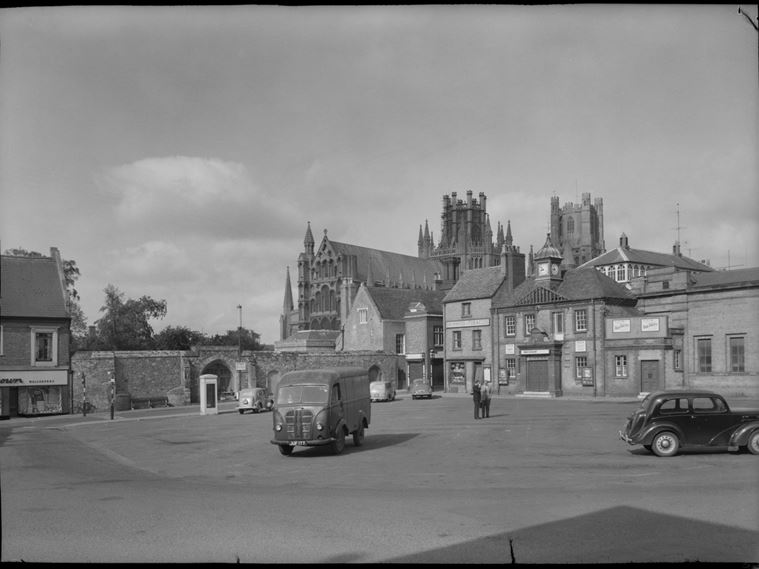
East Cambridgeshire
Local Authority District
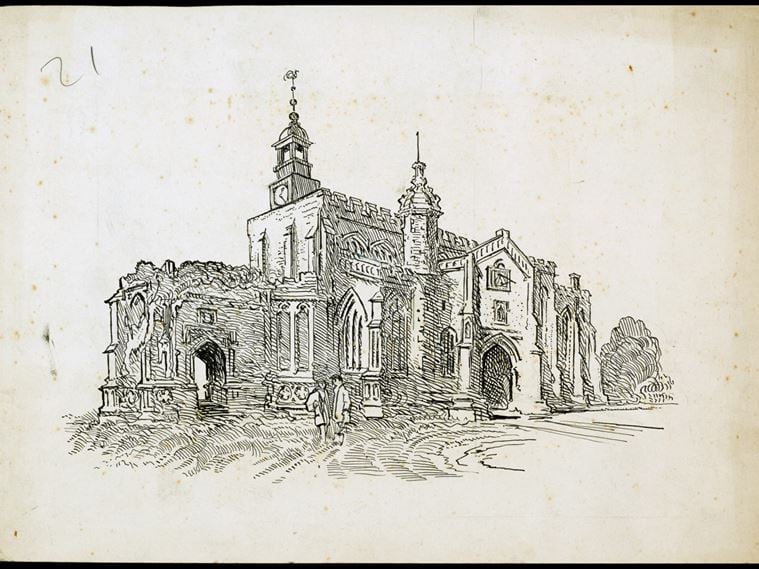
Suffolk
Ceremonial County

Babergh
Local Authority District